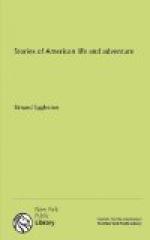[Illustration: Buffaloes.]
The buffaloes had never come down to this lake shore. But one day the lazy Indian looked out and saw a herd of them coming. They were running out on the point of land where his teepee stood. He knew that when they got to the ice on the lake they would turn back.
“Quick, quick!” he called to his wife. The two ran right into the midst of the herd. It was a dangerous thing to do, but they were so hungry and miserable that they did not mind the danger. By running into the herd they separated the buffaloes out on the point from the rest.
When the buffaloes on the point came to the ice, they paused and turned back. They were soon running in the other direction, but the lazy Indian and his wife faced the animals as they came. They waved their ragged blankets at the buffaloes. They shouted in Indian fashion, “Yow-wow, yow-wow, yow-wow!” They ran to and fro, waving and shouting.
Once more the buffaloes stopped and looked. Lazy-man and his wife now ran at them, throwing their blankets in the air, and yelling more wildly than ever. The scared buffaloes turned about again. They were so badly frightened this time that they ran out on the ice on the lake.
The ice was as smooth as glass. The buffaloes could not stand up on it. One after another they slipped and fell. The lazy Indian was not lazy that day. He saw a chance to get out of his poverty. He ran about on the ice, killing the buffaloes.
For many days he and his squaw worked. They skinned the buffaloes, and dried the skins. They prepared the stomachs of the buffaloes, and stuffed them with the chopped meat, making it look like great sausages as big as pillows. They put a few cranberries in with the meat to give the pemmican a good taste. Then they poured the smoking fat of the buffalo into this great sausage. The fat filled up the small spaces. When it got cold, the pemmican sack was almost as hard as a stone. It could be cut only by chopping it with a tomahawk.
At last spring came, and the tribe came home from the hunt. You may suppose that Lazy-man was proud that day. Instead of being the poor beggar whom everybody laughed at, he was now one of the rich men in the tribe. He had more buffalo robes and more pemmican than any other man in the village. He exchanged his buffalo robes for ponies. After that he always went on the hunt, and lived like the other Indians. He did not wish to sink into laziness and poverty again.
PETER PETERSEN.
A story of the Minnesota Indian war.
Peter Petersen was a very little boy living in Minnesota. He lived on the very edge of the Indian country when the Indian War of 1862 broke out.
Settlers were killed in their cabins before they knew that a war had begun. As the news spread, the people left their houses, and hurried into the large towns. Some of them saw their houses burning before they got out of sight. The roads were crowded with ox wagons full of women and children.




